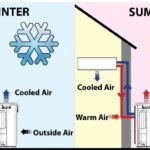If a system undergoes a thermodynamic process or cycle, the first law gives a quantitative estimate of the heat and work between the system and surroundings. However, it fails to say whether the processes or the cycle in a particular direction would occur at all or not. This problem can be solved on the basis of the Second law of Thermodynamics. It states what the possible processes between the system and the surroundings are.
The second law of thermodynamics can be stated in different ways but, there are two classical statements known as The Kelvin-Planck statement and the Clausius statement. The Kelvin-Planck statement refers to a heat engine and the Clausius statement refers to a refrigerator/heat pump.
The Kelvin-Planck Statement
Kelvin-Planck statement of second law is as follows:
的t is impossible to construct a device which will operate in a cycle and produce no effect other than the production of work and exchange of heat with a single reservoir.”
In simple words we can say that a heat engine, which receives heat from a high temperature reservoir, cannot convert that heat completely into work. The only alternative is that an engine should exchange heat with at least two reservoirs, one of these should be a heat absorption reservoir and other should be a heat rejection reservoir. This is just due to satisfying the law of conservation of energy.
The Clausius Statement
The Clausius statement of second law of thermodynamics is given below:
的t is impossible to construct a device which will operate in a cycle and produce no effect other than the transfer of heat from a low temperature body to a high temperature body.”
The statement implies that a refrigerator, which will receive heat from a low temperature reservoir and transfer it to a high temperature reservoir, is impossible. It is only possible when there must be some work input.
These are the two classical statements of the second law of thermodynamics. But, both the statements are similar, i.e. the meaning of both the statements are same.
When the first law of thermodynamics is applied to a process in a closed system, it led to the establishment of a new property named “internal energy.” Similarly, the application of the second law to a process in a closed system leads to the establishment of another property called entropy
Thermodynamic Entropy
Today, the second law is also defined in terms of entropy, i.e. for a closed system, entropy can never decrease. In a reversible process, the entropy changes only if there is heat transfer during the process. If heat is added, then entropy increases, and if there is no heat transfer, then entropy remains constant.
This law for a closed system also refers to the same thing. Entropy is opposite to energy. We already know that the energy of a closed system can never increase without the help of an external element; at the same place entropy can never decrease. If we convert energy form one type to another, then there will be a loss of energy all the time, at the same place there will be always a gain in entropy. You can easily understand this concept if you compare both terms- energy and entropy of a closed system- simultaneously.
I mentioned that entropy is totally dependent on heat transfer. Entropy remains constant only when there is no heat transfer in a closed system. So, we can say that if entropy can be seen to be pretty-much constant, then all life violates the second law of thermodynamics. Because if entropy is constant, then there will be no heat transfer. The whole atmosphere is considered to be a closed system. Due to this, we can imagine the effect of constant entropy in our life. Here’s one example: when you walk on a beach you can feel the effect of heat coming from the Sun, but if the entropy becomes constant, then there will not be any heat transfer between your body and the Sun, and you will not feel the temperate increase in your body. And if there will be no heat transfer from a hot to cold body, then this is a violation of the second law.


